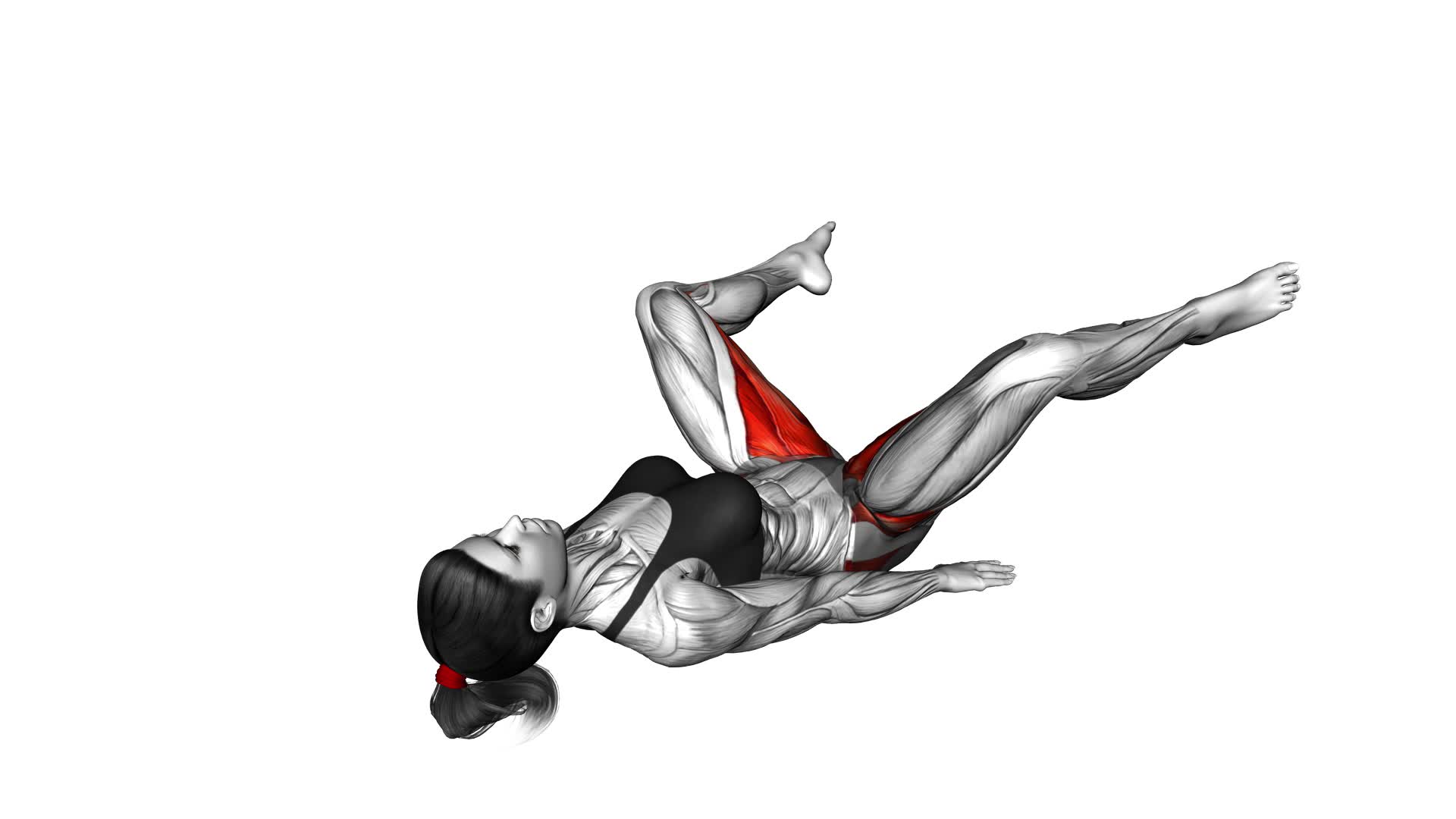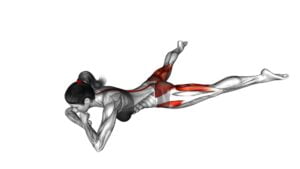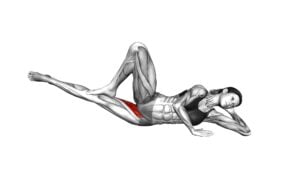Lying Abduction Adduction (female) – Video Exercise Guide & Tips

Are you looking for a challenging exercise to target your hips and thighs? Look no further than lying abduction adduction!
Watch This Exercise Video
This video exercise guide will show you the proper form and technique to maximize your results.
With variations and progressions, you can continuously challenge yourself.
Don't miss out on the benefits of this exercise – incorporate lying abduction adduction into your workout routine today!
Get ready to feel the burn and see the results you're striving for.
Key Takeaways
- Lying abduction adduction exercises target hip muscles, improve hip stability, and reduce the risk of injuries.
- Proper form and technique include lying on your side with legs extended, lifting the top leg for abduction, and bringing the top leg across the body for adduction.
- Equipment such as resistance bands, ankle weights, and an exercise mat can be used to enhance the exercise.
- To ensure proper muscle activation, engage the targeted muscles, avoid relying on momentum, and focus on controlled movements.
Benefits of Lying Abduction Adduction Exercises
You can experience several benefits from performing lying abduction and adduction exercises. These exercises target your hip muscles, specifically the gluteus medius and minimus, which are responsible for stabilizing your hips and thighs. By strengthening these muscles, you can improve your overall hip stability and reduce the risk of injuries.
Lying abduction exercises involve lifting your leg out to the side while lying on your back, while lying adduction exercises involve bringing your leg back to the midline. Both exercises work together to target different muscle groups and provide a balanced workout for your hips.
One of the major benefits of lying abduction and adduction exercises is improved hip strength and mobility. Strong hip muscles can enhance your athletic performance, making movements such as running, jumping, and changing direction more efficient. Additionally, these exercises can help alleviate hip pain and discomfort caused by muscle imbalances or tightness.
Furthermore, lying abduction and adduction exercises can also improve your overall body posture. When your hip muscles are weak, it can lead to poor posture and alignment, which can cause pain and discomfort in your lower back and hips. By strengthening these muscles, you can improve your posture and reduce the risk of chronic pain.
Incorporating lying abduction and adduction exercises into your fitness routine can provide numerous benefits for your hip muscles. Whether you're an athlete looking to improve performance or someone seeking relief from hip pain, these exercises can help you achieve your goals and maintain a healthy, functional body.
Proper Form and Technique for Lying Abduction Adduction
To perform lying abduction and adduction exercises with proper form and technique, it's important to focus on engaging your hip muscles and maintaining control throughout the movements. These exercises have numerous benefits, such as strengthening the hip abductors and adductors, improving hip stability, and enhancing overall lower body strength.
To ensure proper form, lie on your side with your legs extended. For lying abduction, lift your top leg upward while keeping it straight. Make sure to avoid rotating your hips or lifting your pelvis off the ground. Lower your leg back down with control and repeat for the desired number of repetitions.
For lying adduction, start with your legs slightly apart. Bring your top leg across your body, towards the ground, while keeping it straight. Avoid rotating your hips or lifting your pelvis. Return your leg to the starting position with control and repeat.
To progress these exercises, you can add resistance bands or ankle weights to increase the intensity. You can also perform the exercises on a stability ball or foam roller to challenge your balance and stability.
Remember to always listen to your body and start with lighter weights or resistance if you're a beginner. Focus on maintaining proper form and technique throughout the exercises to maximize their effectiveness and minimize the risk of injury. Keep pushing yourself and stay consistent to see improvements in your hip strength and overall fitness.
Equipment Needed for Lying Abduction Adduction
For lying abduction and adduction exercises, you'll need specific equipment to enhance the effectiveness of the movements and provide additional resistance. Here are three essential items you should have for these exercises:
- Resistance Bands: These bands are a great tool for adding resistance to your lying abduction and adduction exercises. They come in various levels of resistance, allowing you to gradually increase the challenge as your muscles get stronger. Attach the bands to your ankles and use them to provide constant tension throughout the movements, maximizing muscle activation.
- Ankle Weights: Ankle weights are another excellent option for increasing resistance during lying abduction and adduction exercises. They strap onto your ankles and add extra weight, challenging your muscles to work harder. Start with a lighter weight and gradually increase as your strength improves.
- Exercise Mat: Having a comfortable and supportive exercise mat is important for proper equipment setup during lying abduction and adduction exercises. It provides cushioning for your body and helps to stabilize your movements. Look for a non-slip mat that provides enough grip to keep you stable during the exercises.
Common Mistakes to Avoid During Lying Abduction Adduction
To get the most out of your lying abduction adduction exercises, it's important to avoid common mistakes that can hinder your progress and put you at risk of injury.
One common mistake is incorrect form, which can lead to ineffective muscle activation and potential strain on the joints.
Proper muscle activation techniques and ensuring the correct equipment setup are also crucial for maximizing the benefits of this exercise.
Stay focused, maintain proper form, and you'll be on your way to stronger and more toned hip muscles.
Incorrect Form Dangers
Avoiding these common mistakes during lying abduction adduction exercises is crucial for maintaining proper form and preventing potential injuries. Here are three incorrect form dangers to watch out for:
- Using momentum: Swinging your legs or using momentum to complete the movement can put excessive strain on your hip joints and shift the focus away from the targeted muscles. To avoid this, focus on controlled and deliberate movements throughout the exercise.
- Overarching your lower back: Arching your lower back excessively can lead to lower back pain and increase the risk of injury. Keep your core engaged and maintain a neutral spine position throughout the exercise.
- Lifting your head: Lifting your head off the bench can strain your neck and compromise your form. Keep your head relaxed and supported by the bench throughout the exercise.
Proper Muscle Activation Techniques
Maintain proper muscle activation during lying abduction adduction exercises to optimize results and reduce the risk of injury.
Proper muscle activation ensures that you're targeting the correct muscles and maximizing the benefits of the exercise. By engaging the targeted muscles, such as the glutes and inner thighs, you'll strengthen and tone these areas more effectively.
It's important to avoid common mistakes that can compromise muscle activation. One common mistake is relying too much on momentum instead of using controlled movements. Another mistake is using excessive weight, which can lead to improper form and decreased muscle activation.
To ensure proper muscle activation, focus on using a weight that allows you to perform the exercise with proper form and control. Additionally, consider modifications such as using resistance bands or adjusting the range of motion to suit your fitness level.
Equipment Setup Importance
Ensure proper equipment setup to maximize the effectiveness and safety of your lying abduction adduction exercises. Here are three key points to keep in mind:
- Warm up exercises: Before starting your lying abduction adduction routine, it's crucial to warm up your muscles properly. Engage in dynamic stretches and movements that target your hip muscles to prepare them for the exercise. This will help prevent injuries and optimize your performance.
- Equipment adjustments: Pay attention to the settings on the machine or bench you're using for lying abduction adduction. Ensure that the equipment is adjusted to your body size and comfort level. Incorrect adjustments can lead to poor form and reduced effectiveness of the exercise.
- Alternative exercises: If the lying abduction adduction machine or bench isn't available, don't worry! There are alternative exercises that can target the same muscles. Side-lying leg lifts or resistance band exercises can be effective substitutes.
Variations and Progressions for Lying Abduction Adduction
Now that you've mastered the basic lying abduction adduction exercise, it's time to explore some variations and progressions to challenge your muscles even more.
By adjusting the difficulty levels, you can continue to strengthen and tone the targeted muscle groups, such as the glutes, hips, and inner thighs.
Difficulty Levels for Progression
Challenge yourself and increase the difficulty of your lying abduction adduction exercises with these variations and progressions.
Here are three modification options to help you progress through different levels:
- Resistance Bands: Attach a resistance band around your ankles to add resistance and intensify the exercise. This will challenge your muscles even more and help you build strength.
- Weighted Ankles: Hold a weight plate or dumbbell between your feet to increase the load on your muscles. This will require extra effort and help you build muscle endurance.
- Single-Leg Variation: Lift one leg off the ground while performing the exercise to focus on one side at a time. This will further challenge your stability and engage your core muscles.
By incorporating these progression levels and modification options, you can continue to challenge your body and make progress in your lying abduction adduction exercises.
Now, let's delve into the muscle groups targeted by these exercises.
Muscle Groups Targeted
The lying abduction adduction exercise primarily targets the hip abductor and adductor muscles. These exercises are great for strengthening the muscles on the sides of your hips, which are crucial for stability and mobility.
By performing lying abduction adduction exercises, you can improve your hip strength and stability, enhance your balance, and prevent injuries. These exercises involve lying on your side and lifting and lowering your top leg in different directions to target the hip muscles. You can add resistance by using ankle weights or resistance bands to make the exercises more challenging.
By incorporating lying abduction adduction exercises into your workout routine, you can effectively target and strengthen your hip muscles, leading to improved overall lower body strength and function.
Now, let's move on to some tips for incorporating lying abduction adduction into your workout routine.
Tips for Incorporating Lying Abduction Adduction Into Your Workout Routine
To effectively incorporate lying abduction adduction into your workout routine, it's important to prioritize proper form and engage your core muscles throughout the exercise. By following these tips, you can maximize the effectiveness of this exercise and achieve your fitness goals:
- Incorporate resistance: To increase the challenge and build strength, consider using resistance bands or ankle weights during the exercise. This will help target and engage the muscles in your hips and thighs even more.
- Modify intensity: If you're just starting out or looking for a lower-impact option, you can modify the intensity of the exercise by using lighter resistance or reducing the range of motion. Gradually increase the intensity as your strength and endurance improve.
- Focus on proper form: Pay attention to your body alignment and make sure your hips, knees, and ankles are in a straight line throughout the exercise. Avoid arching your back or swinging your legs, as this can put unnecessary strain on your lower back. Engage your core muscles to maintain stability and control.
Remember to always listen to your body and adjust the exercise as needed. Consistency and proper form are key to obtaining the best results.
Frequently Asked Questions
Can Lying Abduction Adduction Exercises Help Me Lose Weight?
Lying abduction adduction exercises can definitely help with weight loss. They target the inner and outer thighs, which are common trouble areas for many people. While they may not burn as many calories as some other exercises, they can still contribute to overall weight loss when combined with a healthy diet and consistent exercise routine.
Additionally, these exercises can improve muscle tone, increase flexibility, and enhance overall fitness. So, give them a try and see the difference they can make in your weight loss journey.
How Often Should I Perform Lying Abduction Adduction Exercises?
To get the most out of lying abduction adduction exercises, it's important to know how often to perform them. These exercises have numerous benefits, such as strengthening your hip muscles and improving stability.
To see results, aim to do them at least two to three times a week. Start with proper form, lying on your side with your legs stacked and lifting one leg up and down.
Consistency is key, so make it a regular part of your routine.
Can Lying Abduction Adduction Exercises Help Improve My Balance?
Lying abduction adduction exercises can definitely help improve your balance. By engaging the muscles in your hips and thighs, these exercises promote stability and strengthen the supporting muscles.
The controlled movements in a lying position allow for targeted muscle activation, which is key for better balance.
So, if you're looking to enhance your balance and feel more steady on your feet, incorporating lying abduction adduction exercises into your routine is a great idea.
Keep up the good work!
Are There Any Modifications for Individuals With Knee or Hip Injuries?
If you have knee or hip injuries, there are modifications you can make to the lying abduction adduction exercises.
Instead of doing the traditional exercises, you can try alternative exercises that put less strain on your knees and hips.
These modifications will help protect your injured joints while still allowing you to work on improving your balance and strengthening your muscles.
Don't let injuries hold you back – find the right exercises for your body!
Can Lying Abduction Adduction Exercises Be Done Without Any Equipment?
Lying abduction adduction exercises can be done without any equipment. They're a great way to target and strengthen the muscles in your hips and thighs. By performing these exercises at home, you can improve your overall lower body strength and stability.
The benefits of lying abduction adduction exercises include increased hip mobility, improved balance, and reduced risk of injury. So, get started and enjoy the benefits of these effective exercises from the comfort of your own home!
Conclusion
Incorporating lying abduction and adduction exercises into your workout routine can provide numerous benefits, such as strengthening your hip muscles and improving overall lower body stability. By maintaining proper form and technique, using the necessary equipment, and avoiding common mistakes, you can maximize the effectiveness of these exercises.
Additionally, don't be afraid to explore variations and progressions to challenge yourself further. So, get started and enjoy the benefits of lying abduction and adduction for a stronger and more stable lower body.

Author
Years ago, the spark of my life’s passion ignited in my mind the moment I stepped into the local gym for the first time. The inaugural bead of perspiration, the initial endeavor, the very first surge of endorphins, and a sense of pride that washed over me post-workout marked the beginning of my deep-seated interest in strength sports, fitness, and sports nutrition. This very curiosity blossomed rapidly into a profound fascination, propelling me to earn a Master’s degree in Physical Education from the Academy of Physical Education in Krakow, followed by a Sports Manager diploma from the Jagiellonian University. My journey of growth led me to gain more specialized qualifications, such as being a certified personal trainer with a focus on sports dietetics, a lifeguard, and an instructor for wellness and corrective gymnastics. Theoretical knowledge paired seamlessly with practical experience, reinforcing my belief that the transformation of individuals under my guidance was also a reflection of my personal growth. This belief holds true even today. Each day, I strive to push the boundaries and explore new realms. These realms gently elevate me to greater heights. The unique combination of passion for my field and the continuous quest for growth fuels my drive to break new ground.



